New commercial agreements
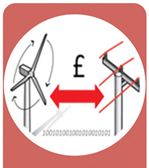 The Low Carbon Hub project (LCH) has demonstrated how Distribution Network Operators (DNO) and generation developers can enter into new innovative commercial arrangements, now referred to as Alternative Connections Agreements. These agreements can unlock additional generation capacity if the generator is willing to operate in a suitable reactive power control mode and to constrain active power export when required. Western Power Distribution (WPD) has been offering cost-effective HV and EHV Alternative Connection Agreements in East Lincolnshire since February 2014 as an alternative to the high cost of conventional network reinforcement. Six Alternative Connections have been accepted, allowing the connection of 48.8MVA of additional new connections at an estimated cost saving of £42m.
The Low Carbon Hub project (LCH) has demonstrated how Distribution Network Operators (DNO) and generation developers can enter into new innovative commercial arrangements, now referred to as Alternative Connections Agreements. These agreements can unlock additional generation capacity if the generator is willing to operate in a suitable reactive power control mode and to constrain active power export when required. Western Power Distribution (WPD) has been offering cost-effective HV and EHV Alternative Connection Agreements in East Lincolnshire since February 2014 as an alternative to the high cost of conventional network reinforcement. Six Alternative Connections have been accepted, allowing the connection of 48.8MVA of additional new connections at an estimated cost saving of £42m.
For the new commercial agreements method to succeed, the project also required hardware –an Active Network Management (ANM) scheme to monitor key network points and to constrain the power export of Alternative DG Connections at times when, otherwise, the network would operate outside of its design and statutory limits. The ANM scheme has been installed and integrated into WPD’s Network Management Software (NMS). This can facilitate the cost effective connection of generation by preventing the less likely, but extreme, system operation scenarios that trigger network reinforcement.
Finally, the project required new network planning skills to understand the impact of Alternative Connections on the network under both normal and abnormal network conditions. Two new constraint analysis software tools were thus specified, designed, tested and used by WPD planners as part of the project. These planning tools provide greater visibility of the network power flows after Alternative Connections have been made. WPD notes that DG developers also need to understand whether an Alternative Connection is suitable for them by performing their own due diligence on the connection and likely future constraints.
33kV active network ring
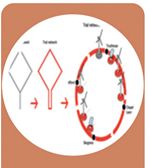
The creation of the ‘active network ring’ allows the network to run with greater controllability. This is possible through increased visibility of power flows and voltage profiles. The arrangement allows the system to be reconfigured, based on the real time status of the network, to optimise system capacity under system stress, which involved installation of new network equipment. Extensive network construction and reconfiguring was carried out at 6 substations to allow two network feeders to be meshed.
This arrangement also increases power flow route diversity, with the associated benefits to system availability and losses reduction.
Network enhancements
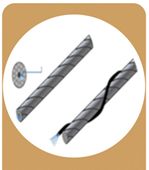
One of the LCH methods was to ascertain what additional functionality should be either designed or built into networks to reduce the costs of connecting future generation. In this trial, key overhead lines (OHL) that were already being replaced for asset condition reasons were given enhanced capacity specifications, and 300mm2 Hard Drawn Aluminium (HDA) conductors were fitted in place of the original 150mm2 steel reinforced aluminium conductor (ACSR). 10.2km of 33kV network was rebuilt with the larger design standard.
This double cross-sectional area offered half the circuit resistance. Reducing the circuit resistance in this way, unlocked additional network capacity for both conventional and alternative connections, and reduced technical losses.
The project required low latency, high bandwidth telecommunications links between primary substations for network protection and other data requirements. All suitable technologies were investigated and reported on in a review of the available wired and wireless communications media.1 Fibre and microwave comms networks were installed as part of the project.
1. Click here to view the report.
Dynamic system ratings
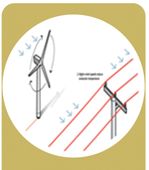
The LCH built on the work of the Skegness 132kV Dynamic Line Rating project in the Registered Power Zone (RPZ) which delivered cheaper connections to the offshore wind farms, giving Western Power Distribution Policy for dynamically rating 132kV tower lines. The LCH has developed a method of dynamically rating 33kV OHLs.
This approach uses new code within the NMS to calculate maximum operating limits for the 33kV OHL based on real time electrical output of wind farms instead of using multiple weather stations.
The method converts the electrical output from multiple turbines into the wind speed at the nacelle height using turbine manufacturer's data. The wind speed at the OHL height is then estimated using the wind shear power law. Finally the wind speed data is incorporated into the Dynamic Line rating algorithm to better estimate the actual maximum circuit rating, thus making best use of all the available information.
Dynamic Voltage Control
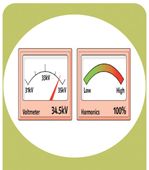
Dynamic Voltage Control (DVC) algorithm, has been incorporated within WPD’s Network Management Software (NMS). It optimises the network voltage using key voltage and current measurement points across the East Lincolnshire network. Both existing Automatic Voltage Control (AVC) relays at Skegness Grid Substation and communications infrastructure have been modified to accept automated remote target voltage changes directly from the NMS. The DVC method can optimise the voltage profile very effectively balancing both demand and generation requirements to unlock capacity.
This element of the LCH project even manages to create an effective data monitoring point where there is no instrument transformer. At Horncastle Primary substation, the DVC requires a 33kV primary voltage measurement. Since there is no 33kV VT, an equivalent signal is being derived from measured values for the 11kV voltage, the real and reactive power through the transformer, its tap position and the transformer’s physical characteristics.
Flexible AC Transmission System (FACT) Device
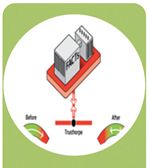
One of the factors that would unlock further network capacity is an improved control of power factor and network voltage. One method of controlling these parameters is to provide (source or sink) shunt compensation through an appropriate shunt-connected device.
One such device is a DStatcom, so the LCH project procured a 3.75MVAr DStatcom for this purpose. It was connected in parallel with the electricity network at Trusthorpe to improve the control, locally, the power factor and network voltage. Through this LCH project the solution was demonstrated for the first time in mainland UK at 33kV. The DStatcom can control the network voltage (boosting the voltage by 3% and bucking the voltage by as much as 5%) and can reduce network losses by balancing circuit reactive power flows.
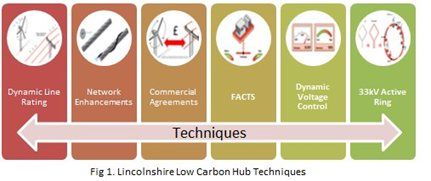

 The Low Carbon Hub project (LCH) has demonstrated how Distribution Network Operators (DNO) and generation developers can enter into new innovative commercial arrangements, now referred to as Alternative Connections Agreements. These agreements can unlock additional generation capacity if the generator is willing to operate in a suitable reactive power control mode and to constrain active power export when required. Western Power Distribution (WPD) has been offering cost-effective HV and EHV Alternative Connection Agreements in East Lincolnshire since February 2014 as an alternative to the high cost of conventional network reinforcement. Six Alternative Connections have been accepted, allowing the connection of 48.8MVA of additional new connections at an estimated cost saving of £42m.
The Low Carbon Hub project (LCH) has demonstrated how Distribution Network Operators (DNO) and generation developers can enter into new innovative commercial arrangements, now referred to as Alternative Connections Agreements. These agreements can unlock additional generation capacity if the generator is willing to operate in a suitable reactive power control mode and to constrain active power export when required. Western Power Distribution (WPD) has been offering cost-effective HV and EHV Alternative Connection Agreements in East Lincolnshire since February 2014 as an alternative to the high cost of conventional network reinforcement. Six Alternative Connections have been accepted, allowing the connection of 48.8MVA of additional new connections at an estimated cost saving of £42m.



